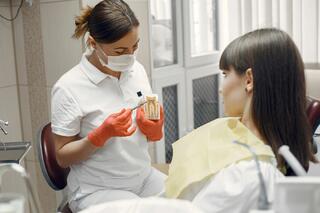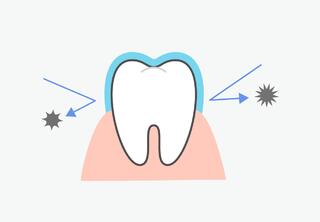What is Tooth Remineralization?
Tooth remineralization is the process of enriching the enamel with minerals to restore its composition and density. Remineralization therapy, involves using products that rejuvenate the enamel's natural composition.
Studies indicate that remineralizing the enamel can lower the risk of developing cavities by 30-65%.

Why is the Procedure Necessary?
Tooth enamel is the body's hardest tissue, with an average thickness of 2.58 mm. It is composed of 95% hydroxyapatite (a mineral made of calcium, fluoride, and phosphate ions), 4% water, and 1% protein compounds.
The mineral content of enamel is variable and changes with the acidity of saliva – the more acidic it is, the more hydroxyapatite crystals break down. This is known as demineralization.
Enamel demineralization is caused by mouth bacteria feeding on sugars and carbohydrates and releasing acids.
The enamel's natural composition self-heals through natural remineralization with calcium ions in saliva. However, irregular brushing and a carbohydrate-rich diet lead to pathological loss of enamel minerals.

Other demineralization causes include:
- Harmful habits, particularly smoking;
- Vitamin deficiency;
- Genetic factors;
- Systemic issues (hormonal disturbances, diabetes, weakened immunity);
- Poor drinking water quality, including low fluoride levels.
Artificial remineralization at a dental clinic might be required to restore the tooth's optimal hard tissue structure.
Indications and contraindications for dental remineralization
Indications
- During and after professional teeth bleaching;
- Loss of the natural luster typical for healthy enamel;
- Preventing tooth decay in both milk and adult teeth;
- Enhanced sensitivity (increased sensitivity of the enamel, response to cold, acidic, or hot stimuli);
- Development of powdery spots on teeth (significant zones of demineralization);
- Replenishing the mineral content of the enamel after wearing orthodontic devices or braces;
- Non-cavity related tooth damage (fluorosis, wedge-shaped defects, cracks, enamel hypoplasia).
Contraindications
- Fluorosis (products containing fluoride are not recommended);
- Allergy to any ingredients of the product.
Types of Tooth Enamel Remineralization
In clinical dentistry, different professional mineralization systems are employed to fortify the enamel, selected by the dentist according to the clinical picture.
- Single-component fluoride varnishes and gels: These contain sodium fluoride or potassium fluoride (at concentrations of 1-5%), forming a fluoride coating when applied to teeth. This coating gradually dissolves upon contact with saliva, enriching the enamel with fluoride and calcium ions.
- Combined products: These include both sodium fluoride and calcium and phosphate compounds, making them more effective on dental tissue than single-component solutions.
These solutions are designed for both clinical and home use.
- Products based on calcium and phosphate without fluoride: Mainly intended for home use, they are meant for a 30-day treatment regimen with applications once or twice daily.
They are self-applied by patients at home.
Classic Remineralization and Fluoride Application
During the classic procedure in the clinic, the dentist applies remineralizing gel or fluoride varnish to the teeth. A combined therapy is also possible: initially treating teeth with gel, then coating them with fluoride varnish.
Fluoride application to the teeth with high-fluoride products is conducted at the clinic either once or over a course of 2-3 treatments within 1-2 weeks.
Following fluoride application, patients are advised to use a remineralizing toothpaste at home.
Pros
- The benefit lasts for half a year;
- Applied once in a clinic;
- Effective in cavity prevention.
Cons
- Not applicable in cases of fluorosis or initial stage of cavities;
- Not suitable for individuals with xerostomia (dryness in the mouth).
Remineralization Therapy Using Trays
Fluoride gel is applied to teeth with tailor-made trays, created from individual dental impressions. The gel acts for 10-15 minutes.
These personalized trays can be used later for mineralization at home. They are also appropriate for teeth whitening, both in the clinic and at home.
Pros
- The treatment reaches even the less accessible areas of the teeth;
- Can be used at home.
Cons
- It is essential to strictly adhere to the dentist's recommendations;
- A series of treatments (15-30 procedures) is required.
Physiotherapeutic Remineralization
Electrophoresis is employed for this, where calcium-based products break down into calcium and phosphate ions. To attain the necessary effect, 10 electrophoresis sessions are needed.
Pros
- An effective approach.
Cons
- Treatment course is necessary;
- Not particularly convenient for patients.
For heightened tooth sensitivity, fluoride varnishes are highly effective. They are applied either once or at intervals of a few days. Subsequently, the patient is prescribed mineralizing toothpaste or gels with a combined formula for home use.
For cavities in the early stage, professional mineralization products based on calcium and phosphates are preferable. Unlike fluoride varnishes, they allow for complete removal of demineralization areas. The patient is also given a product for home application.
How is Enamel Mineralization Performed in Dentistry?
-
Professional oral hygiene and mouth cleanup.
Treats caries and gum diseases. The dentist removes both plaque and tartar, which are sources of pathogens. Hard deposits are eliminated using ultrasound, and soft ones with AirFlow air-abrasive technology. The final step is polishing the enamel surface with dental pastes. -
Applying remineralizing agents.
The tooth surface is dried and treated with calcium, phosphorus, magnesium solutions. The treatment's impact lasts up to 20 minutes. -
Fluoridation.
Finally, the teeth are coated with fluoride varnish.
Recommendations After the Procedure and for Prevention
Following tooth remineralization, it's important to adhere to these guidelines:
- Refrain from eating and drinking for several hours post-procedure;
- Visit the dentist every 3 to 6 months.
- For two days, avoid hot drinks (like tea, coffee), foods that stain, and try to reduce smoking or the number of cigarettes.
- Diversify your diet: cut back on carbohydrates and sugars, and increase the intake of fresh vegetables, fruits, dairy products, fish, legumes, and nuts.
- Change your toothbrush, clean your teeth regularly, use the dentist-prescribed remineralizing toothpaste.
Frequently Asked Questions
What is tooth remineralization?
Remineralization is the process of restoring the mineral composition and density of tooth enamel.
Why is remineralization necessary?
It's essential for strengthening enamel, reducing the risk of cavities, and decreasing tooth sensitivity.
Can the remineralization procedure be done at home?
Yes, it can. There are products designed for home use. However, it's advisable to use them after consulting with a dentist. The dentist will assess the condition of your tooth enamel and recommend a suitable product for home use.
Why is it better to undergo remineralization therapy in a dental clinic?
Firstly, the dentist evaluates the condition of the teeth and identifies any hidden dental diseases. Secondly, professional oral hygiene is performed in the clinic first, making the procedure more effective.
How long does the effect of remineralization last?
The effect can last up to 6 months, but this depends on the method and individual characteristics of the patient.
How often can remineralization be done?
The procedure is recommended every 6 months during routine dental cleanings. For patients with unsatisfactory oral hygiene, the interval is reduced to 3 months.
Is it suitable for pregnant women and children?
Yes, it is suitable, but the dentist carefully selects the products considering any contraindications.











